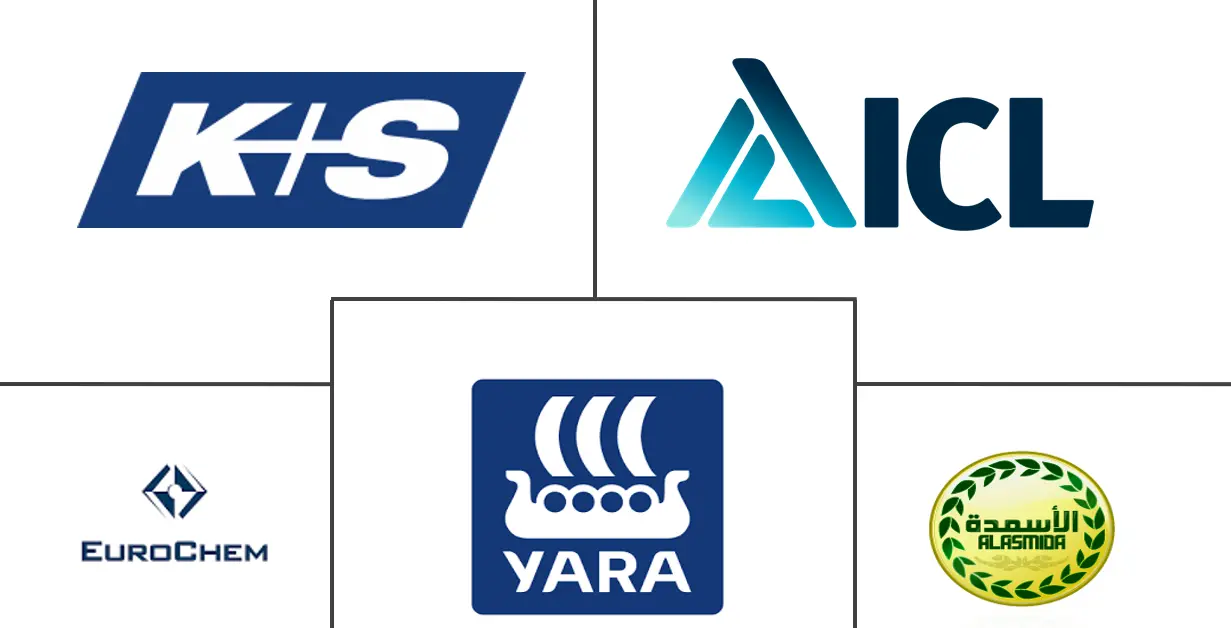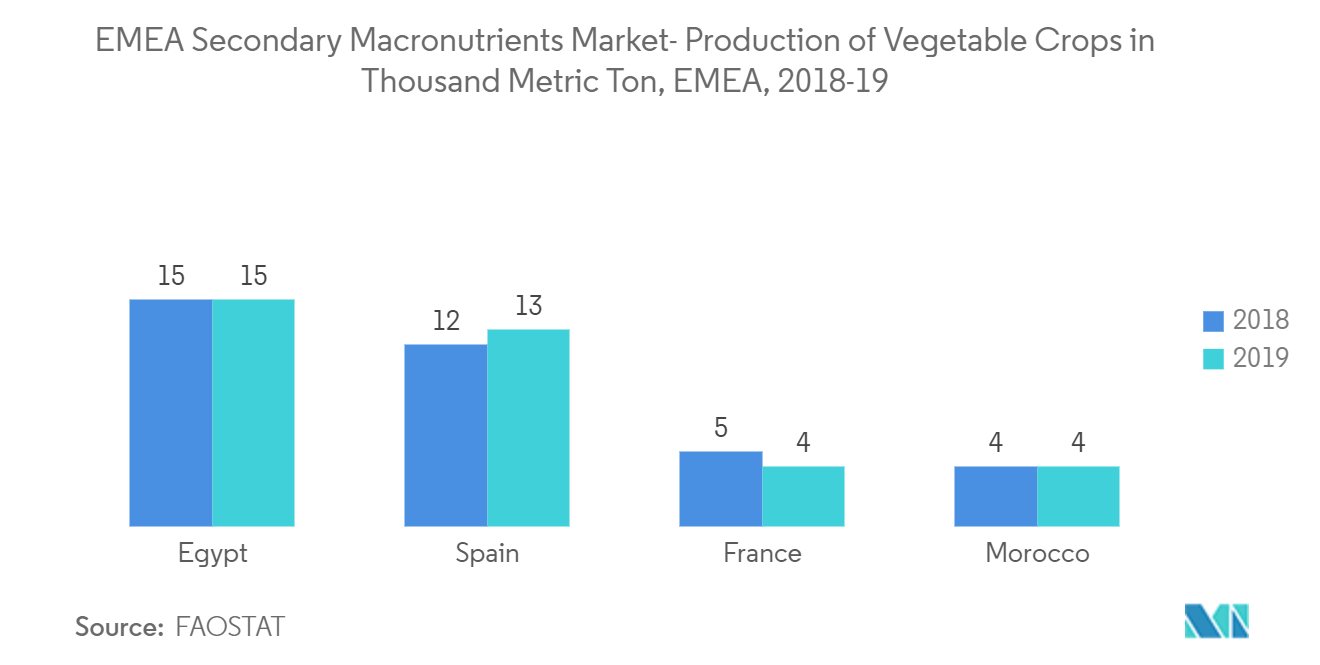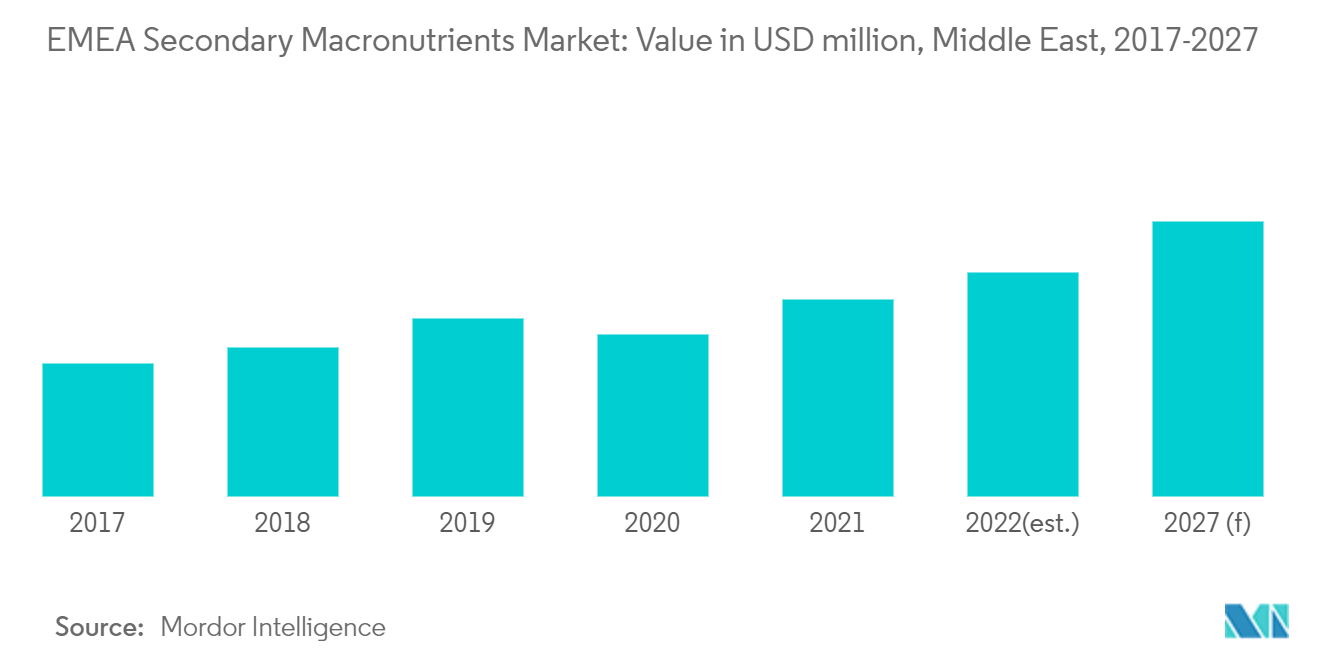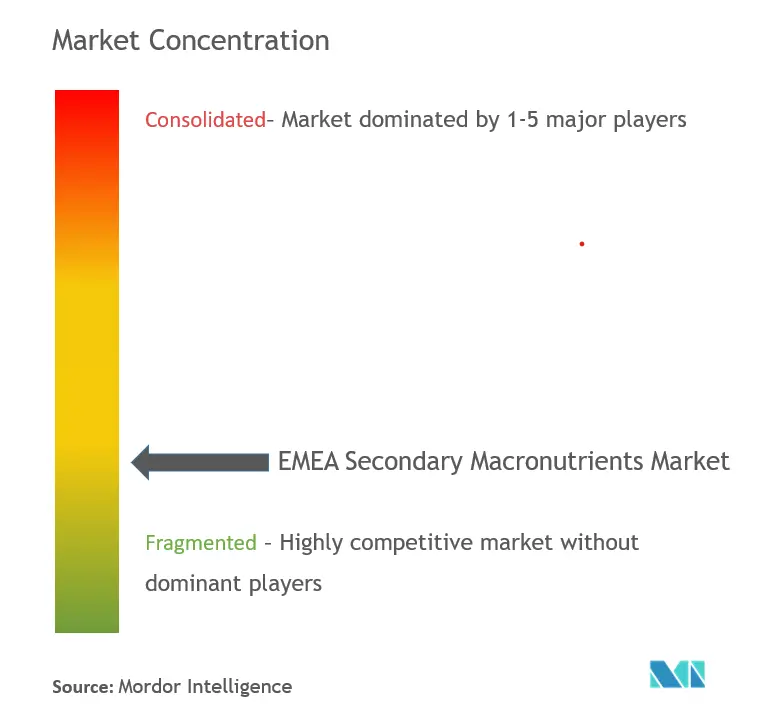EMEA Secondary Macronutrients Market Size

| Study Period | 2019 - 2029 |
| Market Size (2024) | USD 4.23 Billion |
| Market Size (2029) | USD 5.20 Billion |
| CAGR (2024 - 2029) | 4.20 % |
| Fastest Growing Market | Middle East and Africa |
| Largest Market | Europe |
Major Players
*Disclaimer: Major Players sorted in no particular order |
EMEA Secondary Macronutrients Market Analysis
The EMEA Secondary Macronutrients Market size is estimated at USD 4.23 billion in 2024, and is expected to reach USD 5.20 billion by 2029, growing at a CAGR of 4.20% during the forecast period (2024-2029).
The COVID-19 pandemic had a slight negative impact on the market due to various restrictions imposed by the government. During COVID, on the supply side, just like the demand, the logistical issues impacted the runs heavily. For instance, countries in West Africa depend on fertilizer imports from Russia and Belarus, and disruption in supplies from these countries consequently resulted in higher prices.
The secondary macronutrient type includes magnesium (Mg), sulfur (S), and calcium (Ca). The absence of these secondary nutrients stunts the growth of crops. Thus, manufacturers are utilizing secondary nutrient fertilizer that provides flexible options for applications, including pre-plant, starter, side-dress, and fertigation. Consequently, this factor is driving the demand among the farmers in the EMEA region for better crop production. Further, the increase in cereals, fruits, and vegetable production coupled with the growing health awareness in the EMEA countries are also contributing to the market growth.
Among the various macronutrients present in Africa, calcium is anticipated to register the fastest growth owing to the growing use of calcium in plants in their developing stage. The usage of calcium helps improve the health of the soil and enhances its nutrient intake of the soil. As well the use of calcium also ensures faster and greater root mass and better growth of plants.
The active participation of various key players in the are enhancing their existing product line by blending elemental sulfur, calcium, and magnesium with other fertilizers to improve the yield of the resulting blended fertilizers is expected to accelerate the adoption of secondary macronutrients in the region.
EMEA Secondary Macronutrients Market Trends
This section covers the major market trends shaping the EMEA Secondary Macronutrients Market according to our research experts:
Secondary Macronutrients Ensure Healthy Plant Growth
In recent years, due to rigorous farming practices using primary macronutrients, the plants have suffered from secondary micronutrient deficiencies in Europe. Although required in small quantities, secondary macronutrients are highly effective in ensuring the healthy growth of plants. The presence of calcium in plants helps to provide the necessary structural support for the plant cell. Likewise, magnesium is required for photosynthesis as it stimulates the enzymes required for plant growth. Lastly, sulfur is also necessary for moderate quantities, and it helps plants to develop chlorophyll and protein synthesis.
Though required in small quantities, secondary macronutrients are highly effective in ensuring the healthy growth of plants. The presence of calcium in plants helps to provide the necessary structural support for the plant cell. Likewise, magnesium is required for photosynthesis as it stimulates the enzymes required for plant growth.
The demand for increasing agricultural yield to meet the requirements of the growing population further boosts the growth of the secondary macronutrient market in EMEA countries. In the agriculture industry, magnesium salt is included as a fertilizer in the soil to correct its magnesium deficiency. Farmers who produce cash crops and vegetables severely depend on the magnesium-rich earth to create appropriate crop growth conditions. The salt also has high demand from plant nurseries for the efficient development of potted plants. The EMEA countries' population growth coupled with rising disposable income in developing economies has resulted in dietary changes, hence acting as an EMEA secondary macronutrient market driver.

Middle East to Register Fastest Growth
According to the UAE Ministry of Environment and Water (MOEW) and Environmental Agency - Abu Dhabi, the soil of the country is considered one of the most challenging soils in the world. Further, land degradation in the region is increasing salinization, sand violation, waterlogging, and loss of productive topsoil, which, in turn, is encouraging the use of fertilizers that are rich in secondary macronutrients. The manufacturers are offering secondary fertilizers that provide flexible options for application, including pre-plant, starter, side-dress, or fertigation. These are generally compatible with pesticides. Therefore, this factor is driving the demand for secondary macronutrient fertilizers among the farmers in the EMEA region for better yield.
In 2019, Saudi Basic Industries Corporation (SABIC) developed a new product called urea calcium sulfate (UCS), which is the first of a kind fertilizer product that uses the by-product calcium sulfate. UCS is a stable fertilizer that delivers nitrogen along with secondary macronutrients, calcium, and sulfur to the crops. The commercial trial of this product was successfully conducted by the company at the Ibn Al-Baytar plant in 2019. Thus, with the increased demand for secondary nutrients because of the increasing crop cultivation, the use of secondary macronutrients are anticipated to increase in the coming years.

EMEA Secondary Macronutrients Industry Overview
The EMEA Secondary Macronutrients market is fragmented. The key players in the market studied are involved in several strategies, like mergers and acquisitions, partnerships, product innovations, and expansions, to increase their market share and get exposed to new ideas and perspectives to increase their market dominance. In terms of market share, Yara International ASA, Eurochem Group AG, and K+S Company dominate the market studied.
EMEA Secondary Macronutrients Market Leaders
-
Yara International ASA
-
EuroChem Group AG
-
K+S Company
-
Saudi United Fertilizer Co.
-
ICL
*Disclaimer: Major Players sorted in no particular order

EMEA Secondary Macronutrients Market News
In June 2022, K+S signed a letter of intent with the Swedish company CinisFertilizer to cooperate with the synthetic production of potassium sulfate (SOP). This implies that K+S is to supply CinisFertilizer with its entire potassium chloride (MOP) requirements, and in return purchase up to 600,000 metric ton of potassium sulfate (SOP) per year from Cinis.
In March 2021, AnaamInternational Holding Group acquired Al TakamulNational Agriculture Company by signing of Non-Binding Memorandum of Understanding ('MOU') and acquiring 100% of the shares of the company. This will help in the integration with agricultural lands owned by AnaamGroup and this acquisition adds value to the group and its shareholders.
In October 2021, ICL's polysulfate has been approved for use in organic farming. The EU and USDA certified both the standard and granular grades as organic fertilizers.
EMEA Secondary Macronutrients Market Report - Table of Contents
1. INTRODUCTION
- 1.1 Study Assumptions and Market Definition
- 1.2 Scope of the Study
2. RESEARCH METHODOLOGY
3. EXECUTIVE SUMMARY
4. MARKET DYNAMICS
- 4.1 Market Overview
- 4.2 Market Drivers
- 4.3 Market Restraints
-
4.4 Porter's Five Forces Analysis
- 4.4.1 Bargaining Power of Suppliers
- 4.4.2 Bargaining Power of Buyers
- 4.4.3 Threat of New Entrants
- 4.4.4 Threat of Substitute Products
- 4.4.5 Intensity of Competitive Rivalry
5. MARKET SEGMENTATION
-
5.1 Nutrient Type
- 5.1.1 Sulfur
- 5.1.2 Calcium
- 5.1.3 Magnesium
-
5.2 Application Method
- 5.2.1 Solid
- 5.2.2 Liquid
-
5.3 Crop Type
- 5.3.1 Grains And Cereals
- 5.3.2 Pulses And Oilseeds
- 5.3.3 Fruits And Vegetables
- 5.3.4 Turfs And Ornamentals
- 5.3.5 Other Crop Types
-
5.4 Geography
- 5.4.1 Europe
- 5.4.1.1 Germany
- 5.4.1.2 United Kingdom
- 5.4.1.3 France
- 5.4.1.4 Italy
- 5.4.1.5 Spain
- 5.4.1.6 Russia
- 5.4.1.7 Rest of Europe
- 5.4.2 Middle East
- 5.4.2.1 United Arab Emirates
- 5.4.2.2 Saudi Arabia
- 5.4.2.3 Kuwait
- 5.4.2.4 Egypt
- 5.4.2.5 Rest of Middle East
- 5.4.3 Africa
- 5.4.3.1 South Africa
- 5.4.3.2 Morocco
- 5.4.3.3 Nigeria
- 5.4.3.4 Rest of Africa
6. COMPETITIVE LANDSCAPE
- 6.1 Most Adopted Strategies
- 6.2 Market Share Analysis
-
6.3 Company Profiles
- 6.3.1 Al-tayseer Chemical Industry
- 6.3.2 Yara International ASA
- 6.3.3 Eurochem Group AG
- 6.3.4 K+S Company
- 6.3.5 Takamul National Agriculture
- 6.3.6 Saudi United Fertilizer Company (al-asmida)
- 6.3.7 Israel Chemical Company
- 6.3.8 SAF Sulphur Company
- 6.3.9 Haifa Group
- 6.3.10 Trade Corporation International SA
- *List Not Exhaustive
7. MARKET OPPORTUNITIES AND FUTURE TRENDS
8. AN ASSESSMENT OF IMPACT OF COVID-19 OVER THE MARKET
** Subject To AvailablityEMEA Secondary Macronutrients Industry Segmentation
Magnesium (Mg), sulfur (S), and calcium (Ca) are considered secondary macronutrients as they are less commonly yield limiting than the primary macronutrients (P, N, and K), yet are required by crops in relatively larger amounts.
The study provides an in-depth analysis of the EMEA Secondary Macronutrients market. It covers the market scope, size, and growth of the industry. The EMEA Secondary Macronutrients Market is Segmented By Nutrient Type (Sulphur, Calcium, and Magnesium), By Application Method (Solid, and Liquid), By Crop Type (Grains And Cereals, Pulses And Oilseeds, Fruits And Vegetables, Turfs And Ornamentals, and Other Crop Types), and Geography ( Europe, Middle East, and Africa). The report offers the market size and forecasts in terms of value in USD million for all the above segments.
| Nutrient Type | Sulfur | |
| Calcium | ||
| Magnesium | ||
| Application Method | Solid | |
| Liquid | ||
| Crop Type | Grains And Cereals | |
| Pulses And Oilseeds | ||
| Fruits And Vegetables | ||
| Turfs And Ornamentals | ||
| Other Crop Types | ||
| Geography | Europe | Germany |
| United Kingdom | ||
| France | ||
| Italy | ||
| Spain | ||
| Russia | ||
| Rest of Europe | ||
| Geography | Middle East | United Arab Emirates |
| Saudi Arabia | ||
| Kuwait | ||
| Egypt | ||
| Rest of Middle East | ||
| Geography | Africa | South Africa |
| Morocco | ||
| Nigeria | ||
| Rest of Africa |
EMEA Secondary Macronutrients Market Research FAQs
How big is the EMEA Secondary Macronutrients Market?
The EMEA Secondary Macronutrients Market size is expected to reach USD 4.23 billion in 2024 and grow at a CAGR of 4.20% to reach USD 5.20 billion by 2029.
What is the current EMEA Secondary Macronutrients Market size?
In 2024, the EMEA Secondary Macronutrients Market size is expected to reach USD 4.23 billion.
Who are the key players in EMEA Secondary Macronutrients Market?
Yara International ASA , EuroChem Group AG , K+S Company, Saudi United Fertilizer Co. and ICL are the major companies operating in the EMEA Secondary Macronutrients Market.
Which is the fastest growing region in EMEA Secondary Macronutrients Market?
Middle East and Africa is estimated to grow at the highest CAGR over the forecast period (2024-2029).
Which region has the biggest share in EMEA Secondary Macronutrients Market?
In 2024, the Europe accounts for the largest market share in EMEA Secondary Macronutrients Market.
What years does this EMEA Secondary Macronutrients Market cover, and what was the market size in 2023?
In 2023, the EMEA Secondary Macronutrients Market size was estimated at USD 4.06 billion. The report covers the EMEA Secondary Macronutrients Market historical market size for years: 2019, 2020, 2021, 2022 and 2023. The report also forecasts the EMEA Secondary Macronutrients Market size for years: 2024, 2025, 2026, 2027, 2028 and 2029.
EMEA Secondary Macronutrients Industry Report
Statistics for the 2024 EMEA Secondary Macronutrients market share, size and revenue growth rate, created by Mordor Intelligence™ Industry Reports. EMEA Secondary Macronutrients analysis includes a market forecast outlook to 2029 and historical overview. Get a sample of this industry analysis as a free report PDF download.



